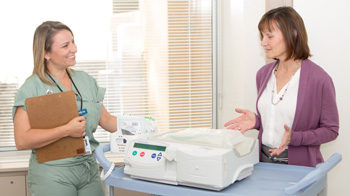Everything in its place

By Kate Manicom

Emily Sestito, a nurse on 8 Cardinal Carter South, shows infection preventionist Lisa Bunn a supply caddy on the peritoneal dialysis machine cart. Keeping supplies with the PD machine, which is moved around the unit, helps to eliminate clutter in patient rooms.
(Photo by Yuri Markarov)
“Paging Marie Kondo…”
The Nephrology/Urology team on St. Michael’s Hospital’s eighth floor has learned the magic of tidying up. After decluttering patient rooms, hallways and nursing stations, along with increased collaboration between nurses, Infection Prevention and Control and the Environmental Services team, the unit has not had a hospital-acquired case of C. difficile since June 2017.
The C. diff. bacterium is the most frequent cause of infectious diarrhea in hospitals. It is spread by touching contaminated surfaces or improper hand hygiene. For healthy people, C. diff. may not pose a risk. But patients like those found on the Nephrology Urology Unit – who are immunocompromised due to dialysis or organ transplant, are already on antibiotics, and are often elderly – are at a greater risk of infection.
After months of struggling with clusters of cases of C. diff., IPAC recommended that the unit address clutter on the unit.
“There’s evidence that hospital cleaning can be linked to outbreaks, and if there is clutter, the environment cannot be cleaned effectively,” said Lisa Bunn, an infection preventionist at St. Michael’s who worked with the team on 8
Cardinal Carter South to address the levels of C. diff.
In patient rooms, care supplies, cleaning products and personal items could be found lining window sills, bedside tables and washroom sinks, making it challenging for the hospital’s Environmental Services team to properly clean surfaces. Common areas such as the nursing station and hallways were filled with equipment and the back room of the nursing station was cluttered with staff belongings and personal items left behind by patients.
8 CC’s tips for decluttering
|
The unit’s Clinical Leader Manager, Colleen Johns, asked Emily Sestito, a
nurse on the unit, to take the lead on implementing specific changes, including educating staff and patients, and reducing clutter in patient care and staff areas.
“I worked closely with Lisa to develop education sessions for our team about C. difficile and how it’s spread,” said Sestito. “And we’re actively educating patients and families about the importance of hand hygiene and keeping surfaces – particularly in the washrooms – as clear of personal belongings as possible.”
The EVS team has also introduced new cleaning supplies and, with the help of improved communication between unit staff and EVS workers, have added protocols for rooms where a patient with C. diff. has stayed.
After decluttering, the unit received a thorough cleaning, including equipment such as workstations on wheels. The team is still doing regular audits of their space and hopes their lessons learned will be helpful for other units in the hospital.
“It’s like keeping order in your own home: a place for everything and everything in its place,” said Sestito.
About St. Michael’s Hospital
St. Michael’s Hospital provides compassionate care to all who enter its doors. The hospital also provides outstanding medical education to future health care professionals in more than 29 academic disciplines. Critical care and trauma, heart disease, neurosurgery, diabetes, cancer care, care of the homeless and global health are among the Hospital’s recognized areas of expertise. Through the Keenan Research Centre and the Li Ka Shing International Healthcare Education Centre, which make up the Li Ka Shing Knowledge Institute, research and education at St. Michael’s Hospital are recognized and make an impact around the world. Founded in 1892, the hospital is fully affiliated with the University of Toronto.
